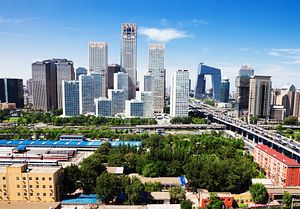Blue skies over Beijing are a rare treat. The city is usually blanketed in smog so thick you can taste it and with stunning regularity one can look directly at the sun. The recent Beijing marathon was run in an Air Quality Index (AQI) of 405, more than 16 times the level deemed unsafe by the WHO. Foreign media featured pictures of people in gas masks, in conditions that one runner described as “running on Mars.”
This is why in the run-up to the APEC Summit, which begins today, Beijing has been furiously attempting to efforts to rein in pollution. The recent blue skies are no accident. Most of the pollution comes from neighboring Hebei province, which is packed with heavy industry such as steel, and which relies on intensely polluting coal to generate the bulk of it’s power. This year Hebei has had nine out of China’s ten most polluted cities.
To clear the skies and allow Beijing a breath of fresh air, the government forced factories to close from November 1, a repeat of the closures ahead of the 2008 Olympics. It has forced cars off the road, and announced a holiday from November 7 to 12 for most government employees. As Vice Premier Zhang Gaoli noted, having clear air for the conference is the “priority of priorities” for China.
The solutions adopted for the APEC Summit are very much short term. They are the climatic equivalent of a Potemkin village, and widespread media coverage of Beijing’s efforts have already precluded any chance of saving face. If during the summit the sky is pearly blue, then people will shrug and note the effort expended to achieve it. When the smog subsequently returns, then the government will look doubly fallible.
Factory owners, aware of the upcoming APEC Summit and pre-empting the shutdowns, shifted production elsewhere. Steel production in Hebei fell 2.9 percent in the first nine months of 2014, although this has been offset by a 9.3 percent increase in Jiangsu province near Shanghai. The planned closures ahead of APEC have not so much solved the problem as merely pushed it southwards. On November 6, Beijing’s AQI was a blissful 25; meanwhile Shanghai languished at 217, the iconic vista of the Bund hazy, as if hastily sketched in charcoal.
Pollution harms China in many ways. The country is already struggling to attract foreign talent. Some Western companies now offer danger pay and the option of relocating employee’s families away from Beijing, doubling the living costs. It also pushes China’s best and brightest to emigrate, contributing to a brain drain.
Moreover, and more perniciously, in the long run pollution is an existential threat to the Chinese Communist Party. CCP rule is maintained by two pillars. The first is nationalism: The CCP united China, expelled the Japanese, and ended the “century of humiliation” at the hands of foreign powers. The second pillar is the famous grand bargain: Let us rule, and your lives will be materially better.
In recent years that second pillar has shown signs of weakening. Quantitative growth has served China well for thirty years, and the increasing fortunes of the Chinese people have allowed them to ignore the costs of breakneck growth. An old Chinese saying goes that food is the god of the people, but now that the Chinese no longer go hungry their demands are more nuanced. In 2012, air pollution contributed to more than 670,000 deaths and the last five years have seen a 40 percent rise in asthma cases.
And so in addition to the temporary measures deployed at critical junctures, the government is putting real resources into trying to find a long-term solution. An indication of how vital an issue this is for the CCP is that over the next five years it plans to spend more than $275 billion on attenuating pollution, an amount that is twice the annual defense budget.
To coincide with the spending, Chinese Premier Li Keqiang declared a “War on Pollution” at the National People’s Congress in March. Rhetoric is important; Li’s words open the door to real reform. After all, it was only a year ago that CCTV was reporting that pollution had many benefits, such as uniting people and making them more knowledgeable. Today, when people can check the AQI on their smartphones, that suggestion seems laughable. In fact, the liberalization of pollution data and the availability of apps may well be the most substantive and important step in facing up to the pollution problem. Not only is the data regional, and updated in real time, but more than 15,000 individual factories have been forced to publish their own data. Instead of trying to sweep the problem under the carpet, Beijing is now acknowledging it.
Once the APEC leaders have packed up and the factories resume their usual activity, Beijing’s smog is likely to return. But these few days of postcard scenery offer a glimmer of hope that one day the government won’t have to literally shift heaven and earth to achieve it.
Barclay Bram Shoemaker is a Shanghai-based writer.

































